Tying Up in Horses and Muscular Health
Updated December 15, 2023 | Reviewed By: Joan Maree Hinken, DVM, CVA, CVSMT
Tying up, or Exertional Rhabdomyolysis, is characterized by muscle pain, stiffness, excessive sweating, and a reluctance to move associated with exercise. Some horses may exhibit signs similar to colic. Once known as “Monday Morning Sickness” or azoturia, it is not the simple muscle soreness a person might experience the day after running or lifting weights. Tying up in horses can be a serious, even life-threatening, condition with multiple causes.
What is Tying Up in Horses?
Tying up has been recognized as a serious condition in horses for over a century. The name “Monday Morning Sickness” comes from the time when draft horses were worked six days a week and given Sunday off to rest in their stalls while fed their normal ration of grain. These horses often displayed signs of tying up when asked to work again on Monday morning. The trigger for an episode seemed to be the combination of returning to work or exercise after a period of enforced idleness while on a high-grain diet.
For many years, tying up was thought to be the result of the build-up of lactic acid in muscles. However, due to advances in exercise physiology and muscle diagnostic testing, it has now been shown that lactic acid build-up in horses does not cause tying up. In fact, veterinarians and scientists now know that tying up is a syndrome with two main types - sporadic and chronic. Each type is affected by muscle proteins, electrolytes, sugars, and conditioning.
Sporadic Tying Up
Sporadic tying up refers to when a horse has a single episode where something external - such as exercise, the environment, or the diet - triggers muscle damage. Sporadic tying up is a temporary or occasional problem in muscle cells that may be caused by fatigue, heat exhaustion, or electrolyte imbalance.
It may occur in any age, breed, gender, or discipline and is not an inherited condition. It is likely to occur when a horse is asked to exercise beyond their conditioning capabilities. Examples include a polo pony used in a match before he was fit enough to compete, a three-day eventer on an especially hot and humid day, or an endurance horse depleted of electrolytes after a 50-mile race.
Chronic Tying Up
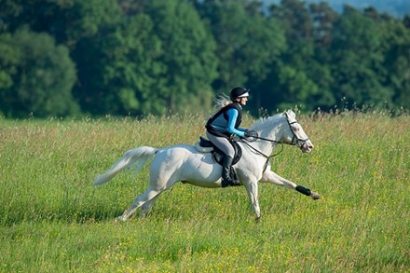
Chronic tying up is an internal problem with the muscle tissue itself. It may still be triggered by exercise and affected by diet, management, and other factors. However, with this form of tying up there is some underlying defect in muscle structure or function causing horses to have repeated episodes.
To further complicate matters, there are different forms of chronic tying up, including Recurrent Exertional Rhabdomyolysis (RER), Polysaccharide Storage Myopathy (PSSM) Types 1 and 2, Myofibrillar Myopathy, and Malignant Hyperthermia.
Recurrent Exertional Rhabdomyolysis (RER) is the term used to describe repeated episodes of tying up specifically due to an inherited abnormality with how calcium is regulated in muscle. This form of chronic tying up has been studied largely in Thoroughbreds but has also been found in Standardbreds and Arabians. Other breeds that may be affected include Quarter Horses and Warmbloods.
The type of horse most associated with this disease is the young (two-year-old), nervous, high-strung thoroughbred filly at the track. However, colts, geldings and mares can be afflicted. Excitement, especially when combined with exercise, seems to be a common trigger for an RER episode in genetically susceptible individuals. Other triggers include stress, lameness, high-grain diets, and specific types of exercise that may create anxiety, such as interval training, being held back from a full gallop, and galloping with one or more other horses.
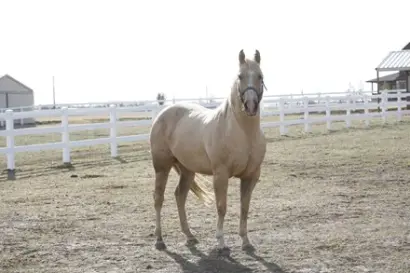
With Polysaccharide Storage Myopathy, or PSSM, the abnormality lies in the way muscle cells handle and metabolize glucose which muscles need for energy. With this form of chronic tying up, glucose is continually processed to become glycogen, the storage form of glucose, and it is abnormally stored in muscles thus rendering the glucose to be unavailable to muscle tissues (PSSM Type 1), or simply stored incorrectly as “clumps” of glycogen (PSSM Type 2).
Certain breeds will display signs and symptoms differently. For example, Quarter Horses tend to show classic signs of tying up (muscle stiffness, cramping, and pain) with either type of PSSM. Signs in other breeds, such as warmbloods, are more along the lines of poor performance, vague or undiagnosed gait abnormalities, a reluctance to collect and engage, loss of muscle mass, progressive weakness, and recumbency (lying down). These may occur with or without exercise.
PSSM is included in this article because it causes signs of classic tying up in some breeds. For more information about this specific condition, please go to our separate article on PSSM in horses.
Recognizing Signs and Symptoms of Tying Up:
The classic signs of a horse experiencing an episode of tying up usually occur shortly after the beginning of exercise or after exercise completion and may include:
- Firm, painful muscles over the loin and croup (lumbar and gluteal muscles)
- Shortened, stiff stride behind
- Anxiety
- Excessive sweating
- Quick, shallow breathing
- Rapid heart rate
- Muscle spasm, twitching, or tremors
- Being reluctant to move or unable to move (could present as refusing to work)
- Reddish-brown or coffee-colored urine (from the breakdown of muscle tissue)
- Lying down/unable to rise (in severe cases)
- Signs of colic
What to Do When a Horse is Tying Up
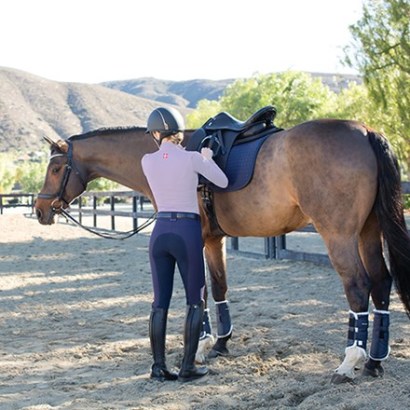
A horse exhibiting signs of tying up should be handled as an emergency. If the horse is currently under saddle or being exercised, any activity must immediately be stopped. Next, call your veterinarian and describe the situation.
While waiting for the vet to arrive, make the horse more comfortable by removing tack, blanketing if it’s cold or providing shade if it’s hot, and holding up water for the horse to drink (he may not be able to lower his head to the ground). If possible, try not to move the horse. Instead, make his surroundings safe and quiet by removing other horses and activities. Follow any specific instructions from the vet such as administering medications, taking vital signs, etc. Do not offer any hay or grain at this time.
When the veterinarian arrives, they will assess the horse, take steps to relieve pain and anxiety, and possibly administer fluids if dehydration is an issue. With vet guidance, the horse may be put into a stall or other confined area since the horse should move as little as possible for the next 24 - 48 hours.
Blood samples may be drawn immediately as well as later in the episode to confirm the diagnosis. Looking at levels of two indicators of muscle damage, creatine kinase (CK), which peaks 6-12 hours after an episode, and aspartate transaminase (AST), which peaks 24 - 48 hours after an episode may give a better understanding of the episode.
Diagnosing Tying Up in Horses
If this is the first time this horse has experienced a bout of tying up, the veterinarian may ask questions to try and figure out what triggered the episode. The diagnosis may be confirmed as “sporadic tying up” and therefore recommendations for the horse may include:
- a complete and balanced diet that includes a balanced vitamin/mineral supplement, high-quality hay, carbohydrates, and additional calories supplied via fats
- being conditioned and fit for the work being asked
- having no other health conditions such as respiratory illness or lameness
- receiving optimal levels of Vitamin E, selenium, and electrolytes
In addition, the vet may recommend a gradual return to exercise, beginning with something as simple as small paddock turnout or hand-walking. The vet may perform rechecks of CK and AST blood levels during this time to know when the horse is ready for more work.
If the horse has had several episodes of tying up in the past, then the veterinarian may lean toward “chronic tying up” as a diagnosis. In this case, they may recommend additional diagnostic testing based on the horse’s history, age, breed, gender, and other factors. Some of these extra tests include genetic assays (test) of blood or hair, muscle biopsy, exercise challenge, and more.
It is important to get to the root cause of chronic tying up as the treatment and management for one type - for example, RER - is different from the treatment and management for other types, such as PSSM1 or PSSM2.
How Long Does it Take a Horse to Recover from Tying Up?
A single episode of tying up may result in muscle healing within three to four weeks without muscle scarring. However, recurrent bouts or an especially severe case of tying up may result in it taking two to four months for the muscle to return to normal.
During this time, your veterinarian may take weekly blood samples to monitor the levels of enzymes such as AST and LDH (lactate dehydrogenase) among others.
Management Recommendations for Horses that Tie Up
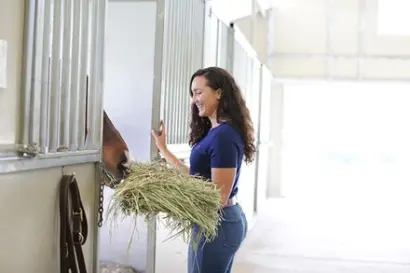
The focus of this section is on horses with the RER form of chronic tying up for two reasons:
First, horses with sporadic tying up may simply need a nutritionally balanced diet with optimal levels of vitamins and minerals. Additionally, a thoughtful turnout schedule, conditioning program, and competition schedule which consider extreme changes in weather or terrain in order to prevent future episodes of tying up.
Second, horses with either type of PSSM have very specific diet and management recommendations covered in detail in a separate article.
Diet and Supplements for Horses that Tie Up
Horses prone to chronic tying up due to RER need a nutritionally balanced diet that is low in NSC (sugar and starch). This may be done by making high-quality forage the foundation of the diet, rounding out the protein, vitamins, and minerals with a low-NSC grain or ration balancer (not sweet feed).
If additional energy is needed this can be accomplished by supplementing with fat from oil or rice bran, or low carbohydrate, highly digestible fiber such as beet pulp or soy hulls. Sources of fat include stabilized rice bran, commercial feeds specifically made for these horses that are low in sugar and high in fat, and powdered fat or oil supplements.
When the horse is sweating heavily from intense exercise or hot temperatures, supplementing with sodium and/or a commercial electrolyte supplying potassium, calcium, and magnesium in addition to sodium and chloride may be appropriate.
Exercise and Prevention
For many RER horses, the combination of stress and exercise may lead to an episode of tying up. The following suggestions from the Michigan State University College of Veterinary Medicine specifically target the Thoroughbred racehorse lifestyle but may be used to help avoid triggering an episode of tying up in any horse prone to recurrent exertional rhabdomyolysis:
- stall in a quiet area of the barn and try to keep the horse’s living space as comfortable as possible
- work this horse first if you have multiple horses to ride
- turn-out as much as possible
- avoid “exciting” training regimens such as: interval training, being held back (restrained) from a full gallop, and galloping with one or more other horses
- reduce stressful situations such as trailering and separation from stablemates
- treat lameness and other medical issues promptly
- avoid stall rest or lay-up if possible
- provide calm exercise if rested the day before
- ask the veterinarian about muscle-relaxing medications such as dantrolene
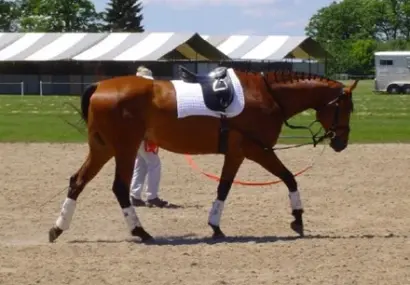
In general, horses that experience the RER form of chronic tying up should receive daily exercise in some form, such as turnout, lunging, and/or riding. A gradual increase in the intensity and duration of exercise is crucial. Consistent, calm exercise is an important part of preventing an episode of tying up in horses.
Key Takeaways
Tying up in horses is not one single disease but a syndrome of muscle disorders affecting many breeds, ages, and disciplines of horses. In some cases, it is an inherited condition that may be diagnosed with a genetic test while in other cases, the underlying cause, method of diagnosis, and even the best ways to treat and prevent it from happening again are unclear.
It is important for riders to understand there are different forms of tying up and there are different signs and symptoms associated with each form. Knowing when tying up is an emergency and warrants a call to the veterinarian is key to ensuring your horse’s health.
Additional Horse Owner Resources on Tying Up
- Video on the signs of tying up vs signs of colic in horses
- Webinar on equine muscle disorders